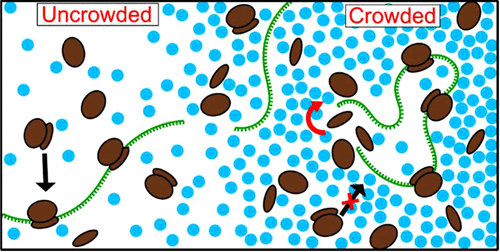当前位置:
X-MOL 学术
›
ACS Synth. Biol.
›
论文详情
Our official English website, www.x-mol.net, welcomes your
feedback! (Note: you will need to create a separate account there.)
Macromolecular Crowding Induces Spatial Correlations That Control Gene Expression Bursting Patterns
ACS Synthetic Biology ( IF 3.7 ) Pub Date : 2018-04-24 00:00:00 , DOI: 10.1021/acssynbio.8b00139 S Elizabeth Norred 1, 2 , Patrick M Caveney 1, 2 , Gaurav Chauhan 3 , Lauren K Collier 1 , C Patrick Collier 1 , Steven M Abel 3 , Michael L Simpson 1, 2
ACS Synthetic Biology ( IF 3.7 ) Pub Date : 2018-04-24 00:00:00 , DOI: 10.1021/acssynbio.8b00139 S Elizabeth Norred 1, 2 , Patrick M Caveney 1, 2 , Gaurav Chauhan 3 , Lauren K Collier 1 , C Patrick Collier 1 , Steven M Abel 3 , Michael L Simpson 1, 2
Affiliation

|
Recent superresolution microscopy studies in E. coli demonstrate that the cytoplasm has highly variable local concentrations where macromolecular crowding plays a central role in establishing membrane-less compartmentalization. This spatial inhomogeneity significantly influences molecular transport and association processes central to gene expression. Yet, little is known about how macromolecular crowding influences gene expression bursting—the episodic process where mRNA and proteins are produced in bursts. Here, we simultaneously measured mRNA and protein reporters in cell-free systems, showing that macromolecular crowding decoupled the well-known relationship between fluctuations in the protein population (noise) and mRNA population statistics. Crowded environments led to a 10-fold increase in protein noise even though there were only modest changes in the mRNA population and fluctuations. Instead, cell-like macromolecular crowding created an inhomogeneous spatial distribution of mRNA (“spatial noise”) that led to large variability in the protein production burst size. As a result, the mRNA spatial noise created large temporal fluctuations in the protein population. These results highlight the interplay between macromolecular crowding, spatial inhomogeneities, and the resulting dynamics of gene expression, and provide insights into using these organizational principles in both cell-based and cell-free synthetic biology.
中文翻译:

大分子拥挤引起控制基因表达爆发模式的空间相关性
最近对大肠杆菌的超分辨率显微镜研究表明,细胞质具有高度可变的局部浓度,其中大分子拥挤在建立无膜区室化中起着核心作用。这种空间不均匀性显着影响基因表达的分子运输和关联过程。然而,人们对大分子拥挤如何影响基因表达爆发(mRNA 和蛋白质爆发式产生的间歇过程)知之甚少。在这里,我们同时测量了无细胞系统中的 mRNA 和蛋白质报告基因,结果表明大分子拥挤消除了众所周知的蛋白质群体波动(噪声)和 mRNA 群体统计数据之间的关系。拥挤的环境导致蛋白质噪音增加了 10 倍,尽管 mRNA 数量和波动只有适度的变化。相反,细胞样大分子拥挤造成了 mRNA 的不均匀空间分布(“空间噪声”),导致蛋白质产量爆发大小的巨大变化。结果,mRNA 空间噪声在蛋白质群体中造成了较大的时间波动。这些结果强调了大分子拥挤、空间不均匀性以及由此产生的基因表达动态之间的相互作用,并为在基于细胞和无细胞的合成生物学中使用这些组织原理提供了见解。
更新日期:2018-04-24
中文翻译:

大分子拥挤引起控制基因表达爆发模式的空间相关性
最近对大肠杆菌的超分辨率显微镜研究表明,细胞质具有高度可变的局部浓度,其中大分子拥挤在建立无膜区室化中起着核心作用。这种空间不均匀性显着影响基因表达的分子运输和关联过程。然而,人们对大分子拥挤如何影响基因表达爆发(mRNA 和蛋白质爆发式产生的间歇过程)知之甚少。在这里,我们同时测量了无细胞系统中的 mRNA 和蛋白质报告基因,结果表明大分子拥挤消除了众所周知的蛋白质群体波动(噪声)和 mRNA 群体统计数据之间的关系。拥挤的环境导致蛋白质噪音增加了 10 倍,尽管 mRNA 数量和波动只有适度的变化。相反,细胞样大分子拥挤造成了 mRNA 的不均匀空间分布(“空间噪声”),导致蛋白质产量爆发大小的巨大变化。结果,mRNA 空间噪声在蛋白质群体中造成了较大的时间波动。这些结果强调了大分子拥挤、空间不均匀性以及由此产生的基因表达动态之间的相互作用,并为在基于细胞和无细胞的合成生物学中使用这些组织原理提供了见解。











































 京公网安备 11010802027423号
京公网安备 11010802027423号